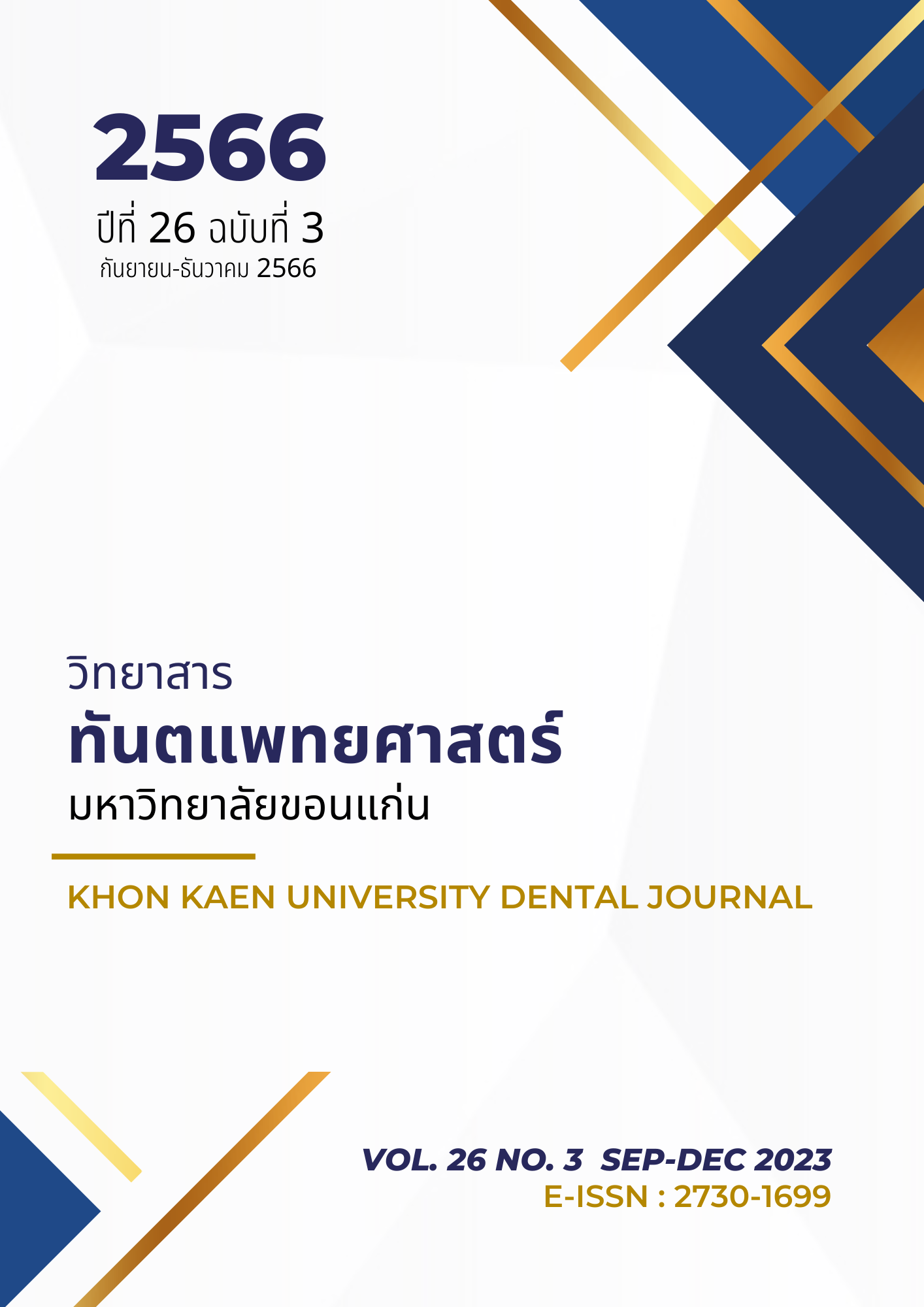The Efficacy of The Coloring Agents from Black Glutinous Rice on Dental Biofilm Staining
Main Article Content
Abstract
The use of disclosing agents is recommended to identify the degree and location of dental biofilm which will facilitate oral hygiene practice and contribute to oral disease prevention. To search for an alternative disclosing agent with good staining ability and biocompatibility from natural products, this study aimed to investigate the efficacy of coloring agents made from black glutinous rice (BGR) on dental biofilm staining. BGR solution was prepared by boiling rice in water and frozen dry to get the dark purple powder, which was later mixed with water at ratio 1:2 before application. The crossover clinical trial was conducted in 36 volunteers who were classified into 3 groups (n=12/group) according to their ages (18-26, 27-46, and 47-66 years old). Within the same age, the volunteers were randomly divided into 2 subgroups to apply either with erythrosine dye (ED) or BGR solution. After a 2-week washout period, the volunteers switched to apply another coloring agent. The stained dental biofilm was recorded 4 sites/tooth as staining, not staining or could not identify, by the examiner and the volunteers. The results showed that BGR solution specifically stained dental biofilm in dark purple colour, it did not stain adjacent gingival or oral tissues as well as tooth-colored restorations. The volunteers could see and completely detect the stained teeth within 15 minutes before color started gradually fading. Kappa coefficients demonstrated the interrater reliability between the examiner and the volunteers from ED and BGR solution were 0.34 and 0.30, respectively. This indicated the same interval of agreement of both disclosing agents. There was no statistically significant difference between both agents among different aged groups. The analysis of tooth surfaces and tooth locations demonstrated the significant difference between both agents on the mesial surface and lower posterior teeth, respectively (Paired t-test; p<0.05). In conclusion, the coloring agents from BGR can stain dental biofilm with desirable properties. Its efficacy is marginally less than ED but it has some superior features regarding being natural, safe, and specific staining. In the form of powder, it is convenient for households to promote oral hygiene care.
Article Details

This work is licensed under a Creative Commons Attribution-NonCommercial-NoDerivatives 4.0 International License.
บทความ ข้อมูล เนื้อหา รูปภาพ ฯลฯ ที่ได้รับการลงตีพิมพ์ในวิทยาสารทันตแพทยศาสตร์ มหาวิทยาลัยขอนแก่นถือเป็นลิขสิทธิ์เฉพาะของคณะทันตแพทยศาสตร์ มหาวิทยาลัยขอนแก่น หากบุคคลหรือหน่วยงานใดต้องการนำทั้งหมดหรือส่วนหนึ่งส่วนใดไปเผยแพร่ต่อหรือเพื่อกระทำการใด ๆ จะต้องได้รับอนุญาตเป็นลายลักษณ์อักษร จากคณะทันตแพทยศาสตร์ มหาวิทยาลัยขอนแก่นก่อนเท่านั้น
References
Marsh PD. Dental plaque as a microbial biofilm. Caries Res 2004;38(3):204-11.
Cugini C, Shanmugam M, Landge N, Ramasubbu N. The role of exopolysaccharides in Oral Biofilms. J Dent Res 2019;98(7):739-45.
Jakubovics NS, Goodman SD, Mashburn-Warren L, Stafford GP, Cieplik F. The dental plaque biofilm matrix. Periodontol 2000 2021;86(1):32-56.
Wang Z, Shen Y, Haapasalo M. Dynamics of Dissolution, Killing, and inhibition of dental plaque biofilm. Front Microbiol 2020;11:964.
Sälzer S, Graetz C, Dörfer CE, Slot DE, Van der Weijden FA. Contemporary practices for mechanical oral hygiene to prevent periodontal disease. Periodontol 2000 2020;84(1):35-44.
Fasoulas A, Pavlidou E, Petridis D, Mantzorou M, Seroglou K, Giaginis C. Detection of dental plaque with disclosing agents in the context of preventive oral hygiene training programs. Heliyon 2019;5(7):e02064.
Datta D, Kumar SGR, Narayanan MBA, Selvamary AL, Sujatha A. Disclosing solutions used in dentistry. World J Pharm Res 2017;6:1648-56.
Yankell SL, Loux JJ. Acute toxicity testing of erythrosine and sodium fluorescein in mice and rats. J Periodontol 1977;48(4):228-31.
Jennings AS, Schwartz SL, Balter NJ, Gardner D, Witorsch RJ. Effects of oral erythrosine (2',4',5',7'-tetraiodofluorescein) on the pituitary-thyroid axis in rats. Toxicol Appl Pharmacol 1990;103(3):549-56.
Jung IH, Yeon KH, Song HR, Hwang YS. Cytotoxicity of dental disclosing solution on gingival epithelial cells in vitro. Clin Exp Dent Res 2020;6(6):669-76.
Kim MH, Lee MH, Hwang YS. Natural blue pigment from gardenia jasminoides Ellis (Rubiaceae) as a dental plaque disclosant. J Dent Hyg Sci 2021;21(1):38-44.
Haryani N, Mahmiyah E, Ayatullah MI. The use of turmeric (extracts and squeeze) to detect plaque on teeth. J info kesehat 2019;17(2):169-75.
Rezki S, Susatyo JH. The role of red dragon fruit peels dyes in red dragon fruit peels detecting the presence of plaque on teeth [monograph on the Internet] Pontianak: Pontianak International Health Conference (PIHC); 2020 [cited 2021 Dec 8]. Available from:https://www. scribd.com/document/ 470419371
Purbaningtyas E. Disclosing agent from red dragon fruit peel as dental plaque indicator. Odonto Dental J 2020;7(1):31-8.
Amaliya A, Firdaus RT, Rusminah N. Natural pigment of red-fleshed pitaya (Hylocereus polyrhizus) as dental plaque disclosing agent- A preliminary study. Istanbul J Pharm 2020;50(3):256-61.
Sivamaruthi BS, Kesika P, Chaiyasut C. Anthocyanins in Thai rice varieties: distribution and pharmacological significance. Int Food Res J 2018;25(5):2024-32.
Khoo HE, Azlan A, Tang ST, Lim SM. Anthocyanidins and anthocyanins: colored pigments as food, pharmaceutical ingredients, and the potential health benefits. Food Nutr Res 2017;61(1):1361779.
O'Leary TJ, Drake RB, Naylor JE. The plaque control record. J Periodontol 1972;43(1):38.
Landis JR, Koch GG. The measurement of observer agreement for categorical data. Biometrics 1977;33(1): 159-74.
Pascual-TeresaMaria S, Sanchez-Ballesta T. Anthocyanins: from plant to health. Phytochem Rev 2008;7(2):281-99.
Wahyuningsih S, Wulandari L, Wartono MW, Munawaroh1 H, Ramelan AH. The effect of pH and color stability of anthocyanin on food colorant. Mater Sci Eng 2017;193:012047
Rose PM, Cantrill V, Benohoud M, Tidder A, Rayner CM, Blackburn RS. Application of anthocyanins from blackcurrant (Ribes nigrum L.) fruit waste as renewable hair dyes. J Agric Food Chem 2018;66(26):6790-8.
Baliga S, Muglikar S, Kale R. Salivary pH: A diagnostic biomarker. J Indian Soc Periodontol 2013;17(4):461-5.
Silva S, Costa EM, Calhau C, Morais RM, Pintado ME. Anthocyanin extraction from plant tissues: A review. Crit Rev Food Sci Nutr. 2017;57(14):3072-83.


